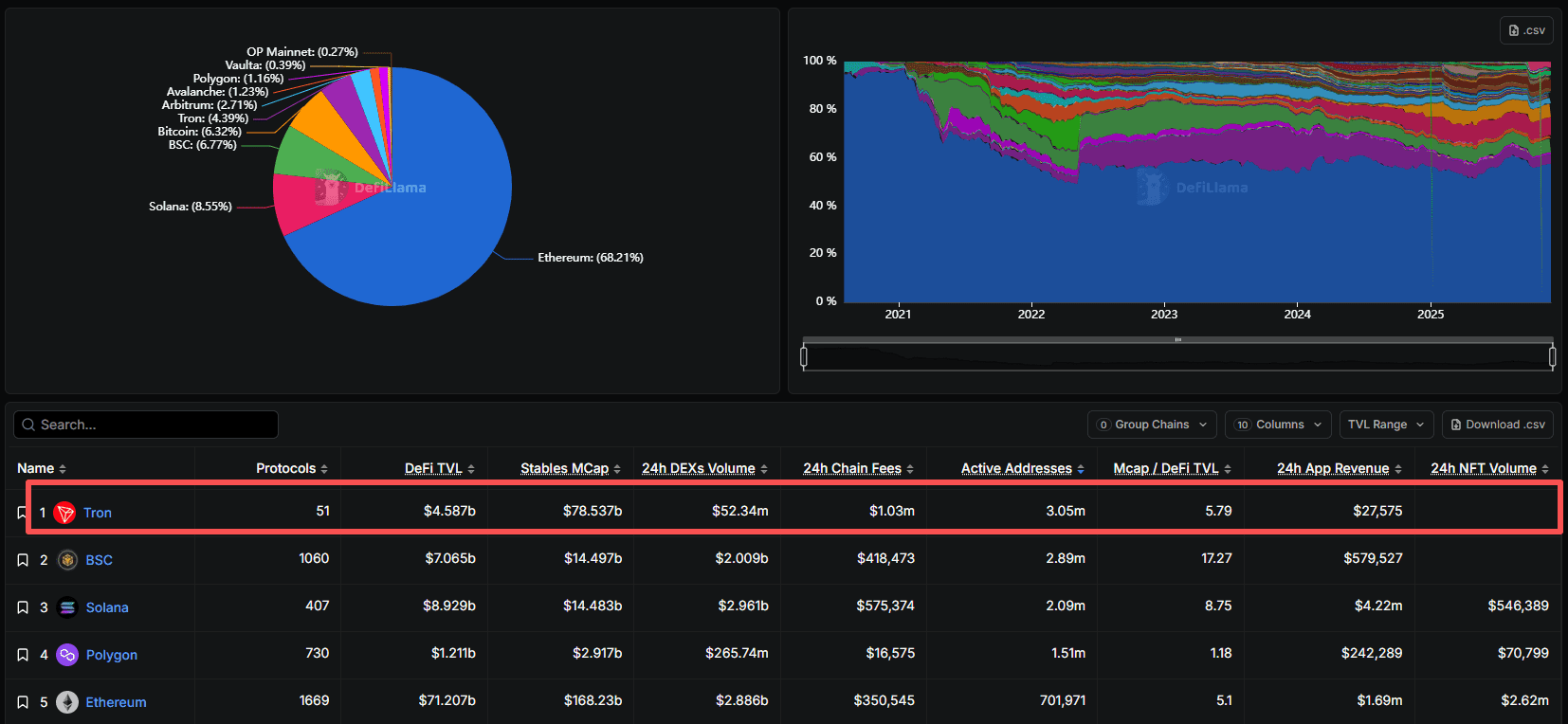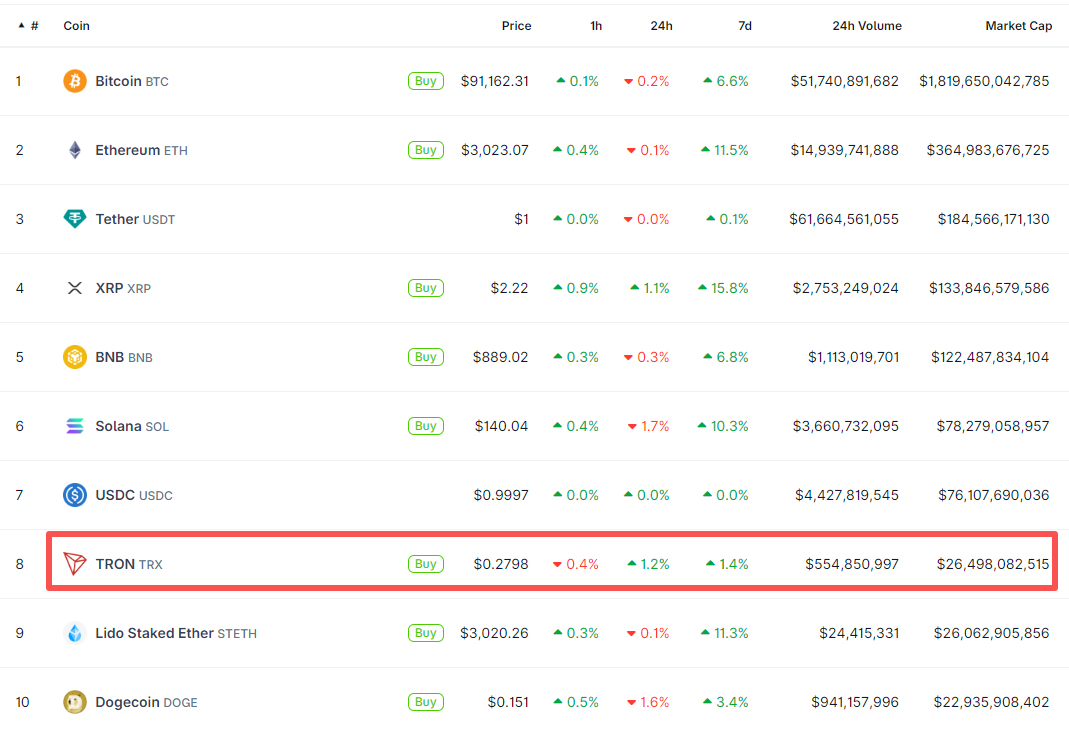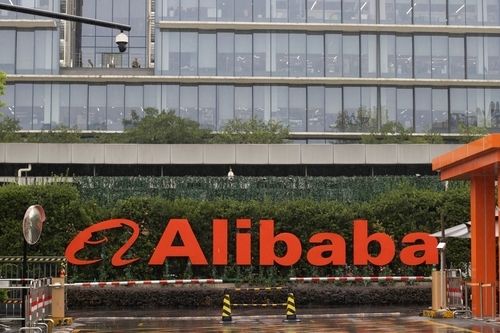What is Tron (TRX)? Will it reach $1 in the future? Is TRX still a worthwhile investment?


TRX Coin News
TradingKey - TRON's ecosystem shows robust growth, boasting significant accounts and a $78.5 billion stablecoin market cap. However, its native token, TRX, has struggled to break past its 2024 high of $0.45, sparking investor skepticism about its path to $1.
As of November 28, 2025, TRON's global total accounts neared 3.5 million, with cumulative transactions exceeding 1.2 billion. Its Total Value Locked (TVL) surpassed $23 billion, and its on-chain stablecoin market capitalization reached $78.5 billion, placing it second only to Ethereum.
In September, Hyperliquid and Aster gained significant traction, igniting a wave of decentralized perpetual contract platforms. TRON founder Justin Sun capitalized on this trend by launching his own decentralized perpetual contract platform, SunPerp, on October 1. The platform has since climbed to 28th place in overall rankings.
On June 16, entertainment company SRM Entertainment, Inc. (SRM) announced the establishment of a TRX treasury and rebranded as Tron Inc. (TRON). According to CoinGecko data, the company has accumulated holdings of 677 million TRX, representing 0.71% of the total supply. Furthermore, the WLFI project, associated with the family of former U.S. President Trump, also holds over 40 million TRX.
Despite TRON's aggressive expansion this year, its native token, TRX, rallied but then retreated, failing to break through its 2024 all-time high of $0.45. This has led the community to question TRX's ability to reach $1. Therefore, will TRX break the $1 barrier? Is now an opportune moment to invest in TRX?
What is TRON (TRX)?
TRON is a decentralized platform focused on digital content, with TRX serving as its native token. Founded in 2017 by young Chinese entrepreneur Justin Sun, the platform aims to enable online content creators to interact directly with users, eliminating the need for intermediaries.
TRON's development can be divided into three phases:
1. Founding (2017–2018): Justin Sun established TRON before the Chinese government banned cryptocurrencies. The project completed its foundational infrastructure and raised approximately $70 million through an Initial Coin Offering (ICO).
2. Ecosystem Expansion (2019–2021): This phase saw the launch of the TRC‑20 standard, which enabled the issuance of stablecoins such as USDT and USDC on the TRON blockchain. It also significantly propelled the development of decentralized finance (DeFi) and non-fungible tokens (NFTs).
3. Internationalization and Compliance (2022–2025): During this period, the VanEck TRX ETN was listed in several European countries. Furthermore, the issuance volume of USDT on the TRON blockchain continued to climb, gradually establishing it as a global payment and financial infrastructure.
What are the application scenarios for TRON?
Tron has evolved beyond a pure decentralized content platform, now functioning as a comprehensive public blockchain akin to Ethereum (ETH). It encompasses various application scenarios, includingpayments, stablecoins, DeFi, NFTs, governance, and content sharing.
Application Category | Specific Scenario | Representative Case |
Stablecoins & Cross-Border Payments | Cross-Border Remittances | USDT-TRC20 |
Enterprise Payments | USDC-TRON | |
DeFi Ecosystem | Decentralized Exchanges | JustSwap |
Lending Protocols | JustLend | |
Liquidity Mining | Sun.io | |
NFTs & Digital Collectibles | Art Trading | APENFT Marketplace |
Game Assets | WINk NFT | |
Collectibles | TRON Meebits | |
Gaming & Entertainment | Gambling Games | WINk Platform |
Blockchain Games | TRON Dogs | |
Live Streaming Entertainment | DLive | |
Content Creation & Distribution | Video Platforms | BitTorrent Integration |
Social Media | TRON Social | |
Digital Publishing | TRON Publishing |
TRX Token Economics
TRX initially issued 100 billion tokens.The initial allocation was as follows:
- Public Sale: Approximately 40% (40 billion TRX), designated for market circulation and early investors.
- Private Investors: Approximately 15% (15 billion TRX), to support project launch.
- Team and Foundation: Approximately 35% (35 billion TRX, unlocked in phases), allocated for foundation operations.
- Ecosystem Development: 10% (10 billion TRX), designated for ecosystem incentives and developer support.
As of publication, the team's portion is largely unlocked.The total circulating supply is approximately 94.6 billion tokens, with the discrepancy mainly attributed to its deflationary mechanism.TRON (TRX) employs four primary burning channels, detailed below:
Burn Type | Trigger Condition | Burn Ratio | Estimated Annual Burn |
Transaction Fees | Every on-chain transaction | 100% of the fee | 80 million - 100 million TRX |
Smart Contract Execution | TRX equivalent to energy consumed | - | 30 million - 50 million TRX |
Governance Resolution Burn | Not fixed | - | Depends on specific proposal |
Special Event Burn | A certain percentage of activity revenue | - | 10 million - 20 million TRX |
What are the advantages and disadvantages of TRX coins?
TRX holds distinct advantages in specific verticals, such as payments and stablecoins, over other public chains. However, it lags key rivals in technological innovation and decentralization, as detailed below:
TRX (TRON) | ETH (Ethereum) | SOL (Solana) | |
Transaction Speed | 2,000+ TPS • 3-second block time • Fast confirmation | 15-30 TPS • 15-second block time • Slows during congestion | 65,000 TPS • Sub-second confirmation • Industry's fastest |
Transaction Cost | $0.001 • Nearly free • Friendly for micro-payments | $1-50 • High during congestion • Heavy burden on users | $0.00025 • Extremely low cost • Cheap for batch operations |
Degree of Decentralization | 27 nodes • Super Representative system • Centralization risk | Thousands of nodes • Globally distributed • Highly decentralized | 2,000+ nodes • Rapid growth • Still needs improvement |
Ecosystem Scale | Stablecoin leader • 50B+ USDT • Strong payment ecosystem | Overall leader • DeFi, NFTs • Largest developer community | Rapid growth • GameFi leader • Many emerging applications |
Technological Innovation | Utility-oriented • Incremental improvements • Originality debates | Continuous innovation • Pioneer of smart contracts • Layer 2 breakthroughs | Architectural innovation • Historically proven • High-performance breakthroughs |
Regulatory Risk | Higher risk • Chinese background • Numerous gambling DApps | Relatively safe • US compliant • High institutional acceptance | Emerging project • Regulatory scrutiny • Compliance ongoing |
Community Governance | DPoS voting • Governed by 27 nodes • Moderate participation | Community-driven • Broad participation • Many governance experiments | Foundation-led • Rapid decision-making • Growing community involvement |
How is TRX performing in the market?
After eight years of development, Tron has achieved considerable success. According to Defillama data, Tron's active addresses exceed 3 million, ranking first among all public chains. Furthermore, its stablecoin market capitalization stands at $78.5 billion, placing it second only to Ethereum. Its Total Value Locked (TVL) across all DeFi projects is approximately $4.5 billion, ranking fourth among public chains.

[Tron Chain Ecosystem Data, Source: Defillama]
As of publication, the TRX coin holds a market capitalization of approximately $26.5 billion, ranking eighth among all cryptocurrencies. This places it above tokens such as Dogecoin (DOGE), Cardano (ADA), and Bitcoin Cash (BCH). While TRX still lags significantly behind Bitcoin (BTC), Binance Coin (BNB), and Solana (SOL), this achievement is remarkable for Tron, a project that initially faced considerable skepticism and criticism.

[Top 10 Cryptocurrencies by Market Cap, Source: CoinGecko]
Will TRX rise to $1?
Bullish catalysts including the Bitcoin halving, Donald Trump's re-election, and U.S. SEC approvals for spot Bitcoin and Ethereum ETFs fueled a strong cryptocurrency rally in 2024, propelling TRX coin to new record highs. On December 4, 2024, TRX coin's price surged to $0.45, breaking its 2018 record and setting a new all-time high. Subsequently, TRX coin's price plummeted by half, falling to $0.20 by February 2025. It has yet to recover to its peak since then. Currently, TRX trades within a wide range, fluctuating between approximately $0.27 and $0.40.

【TRX Price Chart, Source: TradingView】
For TRX coin to reach $1, it would require a 3-4 fold increase from current levels. While not impossible in the crypto market, such a surge would necessitate significant bullish drivers. Currently, potential factors that could propel TRX to $1 include maintaining its stablecoin dominance. Furthermore, new breakthroughs in internationalization and compliance, requiring more countries to recognize TRX as a legal digital currency, could provide a boost. Finally, a new crypto bull market, characterized by significant capital inflows, could rapidly drive up TRX's price.
Is TRX still a worthwhile investment?
TRX is unlikely to hit $1 in the short term, facing a market lacking significant capital and investor confidence after Bitcoin's recent pullback dragged down the broader crypto space. The token requires substantial capital and strong market sentiment, both currently absent from the cryptocurrency market. Bitcoin's recent rally and subsequent retreat have further undermined investor confidence across the board. Furthermore, while Justin Sun aims to advance the Tron ecosystem and enhance TRX's international recognition, progress remains subtle. Only smaller nations or institutions, such as Dominica, have officially recognized and acquired TRX. Consequently, TRX could face a continued short-term pullback, potentially declining to $0.2. Investors should therefore exercise caution.
Medium-term prospects appear more favorable. The Federal Reserve is likely to continue cutting interest rates this year and next, a move that typically benefits risk assets, including U.S. equities and cryptocurrencies. TRX could track this upward trend, potentially rebounding to challenge its historical high of $0.45, representing roughly double its current level. Looking ahead over the next five years, TRX's current price may represent a relatively low entry point. This projection, however, hinges on the project's ability to sustain its competitive advantages and bolster its efforts in cross-border payments and regulatory compliance, particularly in maintaining its dominant position within the stablecoin market. In short, TRX remains a worthwhile investment from a medium- to long-term perspective.
How do I earn TRX coins?
Investors can acquire TRX tokens through various methods, including free or paid options, some requiring active on-chain participation. Choose the strategy best suited to your portfolio.
1. Exchange Purchase
The most direct method is to purchase TRX using fiat or other cryptocurrencies via centralized exchanges (e.g., Binance, Bitfinex) or decentralized exchanges (Uniswap, PancakeSwap).
2. Cryptocurrency Mining
TRON utilizes a DPoS consensus mechanism, meaning direct mining like Bitcoin is not possible. However, users can earn rewards by holding TRX and delegating it to block producers to support network operations.
3. Staking
Many wallets, such as TronLink, enable users to stake their TRX for interest or rewards. This method typically involves locking tokens for a specific period to help maintain network security.
4. Participate in TRON's Reward Programs
TRON's operational model incentivizes block producers to offer TRX rewards to their supporters. By participating in voting and electing block producers, you can receive TRX rewards.
5. Create Content or Applications
Creators can publish content (e.g., videos, music) on the TRON ecosystem and earn TRX through user payments or tips. Developers can build decentralized applications (DApps) on the TRON platform, generating TRX via internal transactions or user services.
6. Participate in Airdrops
Some projects conduct airdrops for TRX holders, allowing you to receive additional TRX or other tokens for free under specific conditions. Investors should monitor TRON or other project airdrop events.
Conclusion
TRX, a utility public blockchain token focused on payments, has established a strong market position in stablecoin transfers. It currently facilitates nearly $80 billion in USDT circulation, becoming the preferred network for cross-border and micro-payments due to its near-zero fees and high-speed transaction experience. However, achieving a $1 price target,while unlikely in the short term, presents a higher probability over the long term. Therefore, investors should allocate TRX based on their individual investment risk and strategy.







